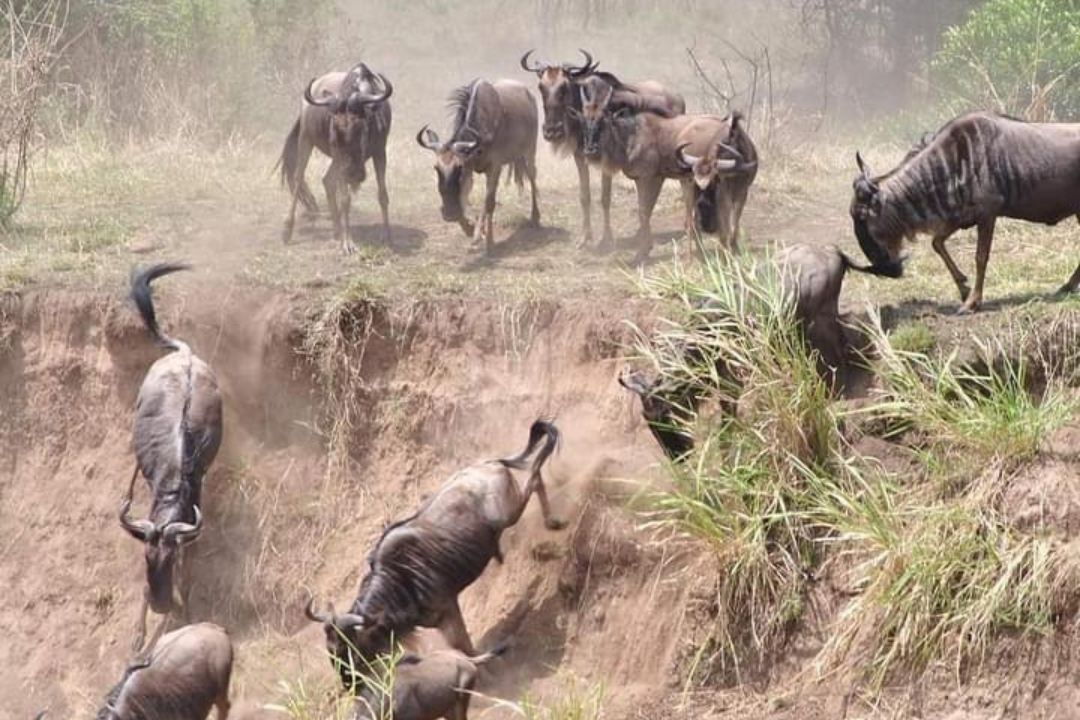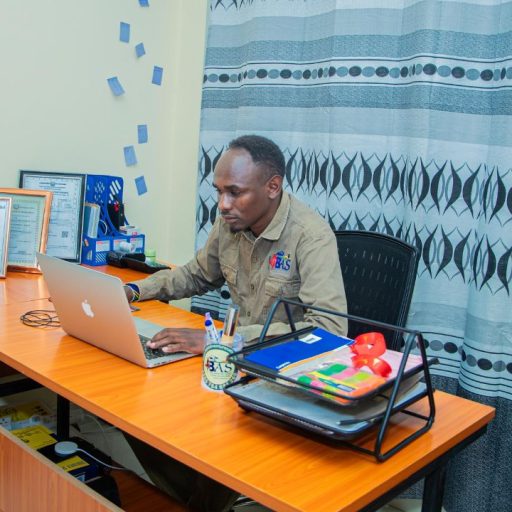Great wildebeest migration tanzania and kenya
Experience the unparalleled spectacle of the Tanzania Great Wildebeest Migration with its epic journey across the vast Serengeti plains. This awe-inspiring natural phenomenon, driven by the search for greener pastures, unfolds as over a million wildebeest, zebras, and other wildlife traverse the Serengeti in a perpetual quest for sustenance. Witness the heart-stopping river crossings, where the herds confront crocodile-infested waters. From December to March, they graze in the Southern Serengeti, while June to October sees them crossing the Grumeti and Mara Rivers. Beeadventure Safari ensures an immersive encounter with this breathtaking migration, a testament to nature’s grandeur.
The Great Wildebeest Migration is not just a safari—it’s the largest and most dramatic movement of animals on Earth. Imagine vast herds stretching across the horizon—up to 1,000 animals per square kilometer—so immense they can even be seen from space. This is the magic of the Serengeti-Mara ecosystem.
Each year, over 1.2 million wildebeest, joined by 300,000 zebras, topis, and gazelles, embark on a never-ending circular journey through Tanzania’s Serengeti National Park and Kenya’s Masai Mara in search of fresh grass and water. Driven by instinct and survival, each animal travels an astonishing 800 to 1,000 km, following ancient migration routes passed down through generations.
🦓 Explore our Great Migration Safari Packages for the best ways to witness this incredible journey firsthand.
The Drama of Survival
But this epic journey is far from easy. Nature’s most fearsome predators—lion, cheetah, leopard, hyena, wild dogs, and crocodiles—lie in wait. River crossings become life-or-death battles, where many lose their lives to currents or hungry jaws. Calves are born into danger, and only the fittest survive. This is why the Great Migration is often called “the greatest wildlife show on Earth.”
Want to see it with your own eyes? Discover our exclusive Serengeti Migration Photography Safari experiences, led by expert guides.
Migration Route Overview
The full migration circuit begins in the Ngorongoro Conservation Area in southern Tanzania (though not within the Crater itself), sweeping north through the Serengeti, then crossing into Masai Mara, Kenya, before looping back again. Each stage offers unique, heart-pounding drama:
- Calving season in Ndutu (Jan–March)
- Grumeti River crossings in Western Serengeti (May–June)
- Mara River crossings (July–October)
- Return to the south with the short rains (Nov–Dec)
- Download our free eBook guide: Planning the Ultimate Great Migration Safari – includes timing tips, maps, and travel advice.
Why Travel with Bee Adventure Safari?
At Bee Adventure Safari, we don’t just show you the Great Migration—we immerse you in it. Whether you’re dreaming of the thunder of hooves, predator chases, or tense river crossings, we design custom safari experiences that put you in the heart of the action.
We offer:
Handpicked migration-focused lodges and camps
Expert local guides with real-time migration updates
Custom itineraries for families, photographers, or honeymooners
✈️ Want to add beach time after your safari? Explore our Zanzibar Beach Holiday Packages.


Embark on a mesmerizing journey with Beeadventure Safari to witness the captivating spectacle of the Tanzania Great Wildebeest Migration. Our curated experience ensures front-row seats to this awe-inspiring natural phenomenon as over a million wildebeest, zebras, and other wildlife traverse the Serengeti in search of greener pastures. Marvel at the heart-stopping river crossings and the breathtaking landscapes that serve as the backdrop to this extraordinary migration. Beeadventure Safari offers expert-guided tours, luxurious accommodations, and an immersive encounter with the Tanzania Great Wildebeest Migration, promising an unforgettable adventure that seamlessly blends comfort with the raw beauty of nature.
The Great Migration in Africa is one of nature’s most incredible survival stories—driven by the search for food, water, and life itself.
Every year, over 1.5 million wildebeest, along with hundreds of thousands of zebras and gazelles, embark on a circular journey through Tanzania’s Serengeti and Kenya’s Masai Mara. But why do they move?
The migration follows the rhythm of seasonal rains. As rains fall in different regions, they transform the dry plains into lush grazing lands. Wildebeest and their companions instinctively follow this green trail, searching for fresh grass and water to sustain their herds.
Another powerful reason for the migration is reproduction. In January to March, the herds gather in southern Serengeti (Ndutu region) for the calving season, where over 8,000 calves are born daily. However, with new life comes danger—predators like lions, hyenas, and cheetahs are never far behind.
By July to September, the herds reach the Grumeti and Mara Rivers, where crocodile-infested waters pose one of the deadliest challenges. These dramatic crossings are not only about getting to greener pastures—they’re a true test of survival.
After the rains return to the south around October to December, the herds begin their long journey back to the Serengeti to start the cycle all over again.
When planning your dream African safari, the choice often comes down to two iconic destinations: Tanzania’s Serengeti National Park and Kenya’s Masai Mara National Reserve. These legendary parks form one continuous ecosystem, teeming with wildlife and breathtaking landscapes—yet they offer unique experiences based on location, seasonality, and activities.
The Serengeti and Masai Mara are geographically connected, creating one of the most wildlife-rich areas in the world. Together, they host the annual Great Wildebeest Migration, one of nature’s most spectacular events.
Despite being one ecosystem, they are divided by an international border and managed separately. This results in different conservation styles, accommodation options, and seasonal patterns that impact your safari experience.
Serengeti National Park (Tanzania):
From December to July, the Serengeti is the stage for dramatic moments of the Great Migration, including the calving season in Ndutu (Jan–March) and thrilling Grumeti River crossings (May–June). The park’s vast plains also ensure excellent year-round game viewing—even outside of migration months.
Masai Mara National Reserve (Kenya):
The herds arrive in Masai Mara around July and stay until October, drawn by lush grazing grounds. This is the best time to witness the famous Mara River crossings, where wildebeest brave crocodile-filled waters. The Mara also offers excellent big cat sightings and cultural interactions with the Maasai community.
Both the Serengeti and Masai Mara are home to:
The Big Five (lion, leopard, elephant, buffalo, and rhino)
Large populations of zebras, giraffes, and gazelles
Predator action, especially lions and cheetahs
Stunning landscapes—from open plains to riverine forests
Even outside the migration season, both parks offer incredible safari game drives, birdwatching, and photography opportunities.
Serengeti offers a wide range of accommodations—from luxury lodges to authentic mobile camps, perfect for following the migration.
Masai Mara is known for its private conservancies, which allow for exclusive game drives, night safaris, and walking tours.
At Bee Adventure Safari, we specialize in creating unforgettable experiences in both Tanzania and Kenya. Whether you’re seeking river crossings in the Masai Mara or the thrill of the Serengeti’s endless plains, we’ll help you plan the perfect trip based on season, interests, and budget.
Experience the Circle of Life with Bee Adventure Safari
At Bee Adventure Safari, we believe that understanding nature’s most magnificent show—the Great Wildebeest Migration—makes your African safari even more unforgettable. Today, we bring you an expert guide’s view to help simplify the migration and shed light on what makes this epic journey a true spectacle of life, survival, and instinct.
The Great Migration is the largest movement of land animals on Earth. Every year, over 1.5 million wildebeest, accompanied by zebras, gazelles, and eland, journey through the Serengeti in Tanzania and Masai Mara in Kenya, forming a continuous circle driven by the search for fresh grazing and water.
But unlike the tidy loops on safari maps, this migration doesn’t follow a strict schedule. Instead, it’s dictated by seasonal rains and weather patterns. That’s why planning your Great Migration safari requires local expertise and flexibility—something our team at Bee Adventure Safari excels at.
From the short grass plains of Ndutu in the southern Serengeti, where the calving season begins around January to March, the herds move northwest through Grumeti, crossing dangerous rivers filled with crocodiles in June and July, and finally reach Kenya’s Masai Mara around July to October.
Then, with the November rains, they start their journey back south—a constant cycle of life, death, and rebirth.
Wherever the herds go, predators follow. Lions, cheetahs, leopards, and hyenas eagerly await the calving season, when hundreds of thousands of baby wildebeest are born in a few short weeks. This window offers incredible game viewing opportunities, as the plains come alive with predator-prey encounters.
Meanwhile, the ecosystem works in harmony. After the herds leave, the landscapes transform. Vultures clean the remnants, big cats rest with full bellies, and even the dung beetles play a critical role, recycling waste and preparing the land for the return of the herds.
Yes, even the smallest creatures have a role in the Great Migration ecosystem. As our guides love to explain, dung beetles are the cleanup crew, processing tons of droppings left behind. These beetles use the sun, moon, and stars to navigate and bury the dung to feed their offspring—an incredible example of how every part of the cycle matters.
One of the most important takeaways from our experienced guides is this: no two years are the same. Rain patterns shift, river crossings vary, and the timing can change from one week to the next. That’s why traveling with a trusted operator like Bee Adventure Safari gives you the best chance to be at the right place at the right time.
Whether you’re chasing the river crossings in Masai Mara or witnessing the calving season in the Serengeti, our local experts are ready to tailor your perfect safari adventure. We help you choose the best time to travel, the ideal accommodations, and the top wildlife spots based on real-time knowledge—not just what’s on the map.
🔗 Ready to follow the herds?
Contact Bee Adventure Safari today to start planning your ultimate Great Migration safari in Tanzania and Kenya.
Experience the wilderness. Witness the drama. Join the migration.


At BeeAdventure Safari, we believe a vacation is far more than booking a hotel, catching a flight, or renting a car. It’s a holistic experience that connects every element into a transformative journey. As we proudly celebrate our 10th Anniversary, we reflect on a decade of curating meaningful adventures that inspire and ignite the soul. Our trips are thoughtfully designed to foster personal growth, creating experiences that transcend expectations. Whether it’s connecting with local cultures, exploring breathtaking landscapes, or overcoming challenges, our mission is to craft journeys that bring lasting value to travelers, local hosts, and the planet.
Join us as we continue redefining travel—creating adventures that leave a lasting impact on the world and your heart.
Build a tailor made trip in less
time
Push your boundaries and experience an adventure
Feel Safe and supported while
traveling
Receive open and honest consultation. Always